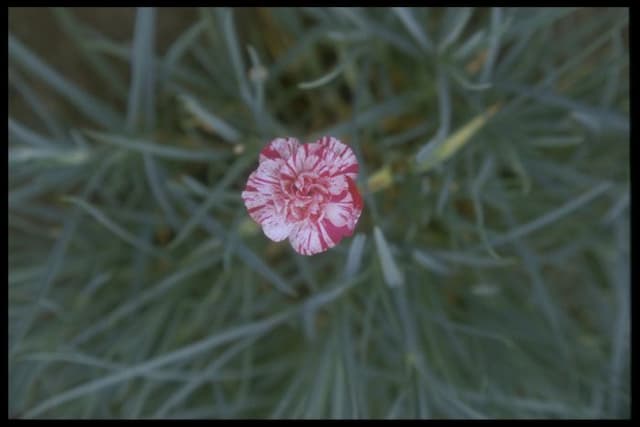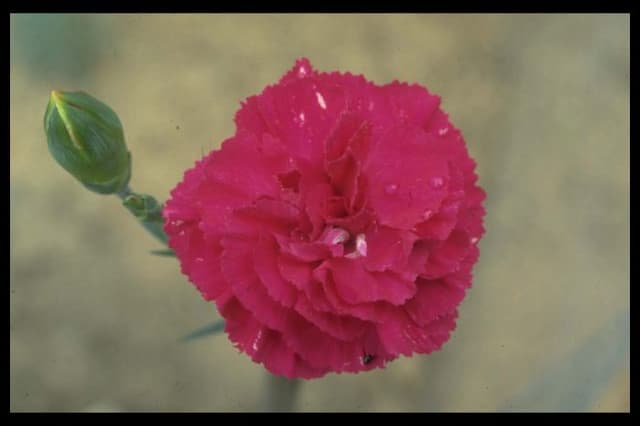Pinks Dianthus 'Widecombe Fair' (p)

ABOUT
Dianthus 'Widecombe Fair', commonly known as pinks, is a charming plant known for its attractive and vibrant flowers. The blooms are notably frilled and often display a mix of pink, white, and red hues, with a pattern that can resemble a picotee edge, where the base color is edged in a contrasting shade. Each petal is delicately laced and often exudes a spicy, clove-like fragrance that adds to its appeal in gardens and as cut flowers. The foliage of the Dianthus 'Widecombe Fair' is slender and bluish-green, forming a dense mat that provides a lovely contrast to the colorful display of flowers sitting atop the slender, sturdy stems. The overall growth habit of the plant is compact and bushy, and it maintains a neat appearance throughout its blooming season. With their striking color and delightful scent, these flowers are a favorite for ornamental borders, rock gardens, container plantings, and are perfect for adding a splash of color to any setting.
About this plant
 Names
NamesFamily
Caryophyllaceae
Synonyms
Pink, Sweet William, Carnation
Common names
Dianthus 'Widecombe Fair'
 Toxicity
ToxicityTo humans
The Dianthus 'Widecombe Fair', commonly known as Pink, is not known to be toxic to humans. There is no significant risk of poisoning from ingesting parts of the Pink plant, and it does not typically result in any adverse symptoms.
To pets
Pink is generally considered to be non-toxic to pets. Ingesting this plant should not cause any significant symptoms of poisoning in animals such as dogs and cats. However, it is always advisable to prevent pets from consuming plants as individual animals may have different reactions or sensitivities.
 Characteristics
CharacteristicsLife cycle
Perennials
Foliage type
Evergreen
Color of leaves
Blue-green
Flower color
Pink
Height
1 foot [30 cm]
Spread
1 foot [30 cm]
Plant type
Herb
Hardiness zones
5
Native area
Europe
Benefits
 General Benefits
General Benefits- Attractive Flowers: Produces beautiful pink flowers with frilled edges that add color and visual interest to gardens.
- Long Blooming Season: Offers a long blooming period from late spring through summer, providing extended garden enjoyment.
- Drought Tolerance: Once established, it has good drought tolerance, requiring less watering and maintenance.
- Fragrance: The flowers emit a pleasant fragrance, which can enhance the sensory experience of a garden.
- Compact Size: With its compact growth habit, it is suitable for small gardens, borders, rockeries, and containers.
- Attracts Pollinators: The flowers attract butterflies and bees, supporting local biodiversity.
- Low Maintenance: Generally requires minimal care beyond basic watering and occasional feeding.
- Deer Resistance: Less palatable to deer, reducing the risk of damage from wildlife.
 Medical Properties
Medical PropertiesThis plant is not used for medical purposes.
 Air-purifying Qualities
Air-purifying QualitiesThis plant is not specifically known for air purifying qualities.
 Other Uses
Other Uses- Dianthus 'Widecombe Fair' can be used in culinary preparations, such as adding the petals to salads for a spicy clove-like flavor and as an attractive garnish.
- The petals of the Dianthus can also be crystallized and used as a decorative, edible addition to cakes and desserts.
- Dried petals of Dianthus may be incorporated into potpourri mixes to add fragrance and color.
- The flowers can be pressed and used in craft projects such as making bookmarks, greeting cards, or pressed flower art.
- Dianthus 'Widecombe Fair' is ideal for creating a colorful, low-growing border along walkways or in garden beds.
- The plant's blooms are suitable for cutting and can be used in fresh floral arrangements to brighten indoor spaces.
- Petals of Dianthus can be used to add color and flavor to ice cubes, making a visually appealing addition to drinks.
- The dense mat-like growth of Dianthus 'Widecombe Fair' can act as a living mulch, helping retain soil moisture and suppress weeds around other plants.
- The essential oil from Dianthus flowers can be used in homemade perfumes or scented sachets to impart a fresh fragrance.
- Beyond their ornamental value, the plants can also serve as indicator species, as they may show signs of distress in the presence of environmental pollutants or soil imbalances.
Interesting Facts
 Feng Shui
Feng ShuiThe plant Dianthus is not used in Feng Shui practice.
 Zodiac Sign Compitability
Zodiac Sign CompitabilityThe plant Dianthus is not used in astrology practice.
 Plant Symbolism
Plant Symbolism- Love: Dianthus is often associated with love and affection, making it a popular choice in romantic bouquets and gestures.
- Admiration: The bright and lively appearance of the Dianthus 'Widecombe Fair', more commonly known as "pinks", can symbolize deep admiration for someone.
- Boldness: The striking and vivid colors of pinks represent boldness and daring, reflecting the flower's confident presence in a garden.
- Pure Affection: Unlike the red rose that is often associated with passionate love, pinks are associated with a more platonic and pure form of affection.
- Devotion: Pinks can symbolize a pledge of loyalty, reflecting the idea of an enduring and committed relationship.
 Water
WaterCarnations require moderate watering to keep the soil moist but not waterlogged. During the growing season, typically from spring to fall, water the plant once or twice a week, depending on the weather conditions; less frequent watering may be required during cooler months or in rainy climates. It's important to provide approximately one inch of water per watering session, allowing the soil to dry out slightly between watering. To avoid fungal diseases, water at the base of the plant rather than from overhead. During hot, dry spells, you might need to increase watering to maintain consistent moisture.
 Light
LightCarnations prefer full sun to thrive, requiring at least six hours of direct sunlight each day. The best spot for these plants is in a location where they will receive plenty of morning sunlight, which is less intense, and some partial shade during the hottest part of the afternoon, especially in very warm climates. Avoid deep shade as it can lead to poor blooming and weak growth.
 Temperature
TemperatureCarnations enjoy cooler temperatures and perform best in an environment where average daytime temperatures range between 60 to 70 degrees Fahrenheit, while they can handle nighttime temperatures down to 50 degrees Fahrenheit. They can survive brief periods of colder weather, down to about 40 degrees Fahrenheit, but frost can be damaging. Carnations are not suited for prolonged exposure to temperatures above 80 degrees Fahrenheit, as excessive heat may result in poor growth and flowering.
 Pruning
PruningPruning carnations encourages healthy growth and prolific blooming. Prune them back after flowering by removing spent blooms and thinning out dense growth to promote air circulation, which helps prevent disease. The best time for major pruning is in early spring to remove old or dead stems and to shape the plant for the upcoming growing season. Light pruning and deadheading can be done throughout the growing season as needed.
 Cleaning
CleaningAs needed
 Soil
SoilThe Sweet William prefers well-draining soil with a neutral to slightly alkaline pH, around 6.5 to 7.5. An ideal soil mix consists of one part garden soil, one part compost, and one part perlite or sand to improve drainage.
 Repotting
RepottingSweet William typically doesn't require frequent repotting and can be repotted every 2-3 years or when it outgrows its current container.
 Humidity & Misting
Humidity & MistingSweet William thrives in average household humidity levels and does not require any special humidity adjustments.
 Suitable locations
Suitable locationsIndoor
Place in a sunny spot, ensure good airflow, and water moderately.
Outdoor
Plant in full sun with well-draining soil and space adequately.
Hardiness zone
3-9 USDA.
 Life cycle
Life cycleDianthus 'Widecombe Fair', commonly known as Pink, begins its life cycle with seed germination, which occurs in a warm, well-draining soil mix under appropriate temperature and moisture conditions. Upon germination, the seedling emerges with its first set of true leaves and continues to grow, establishing a root system and foliage. The vegetative growth phase follows, with the plant developing a compact, bushy form and producing lance-shaped, green-grey leaves. After this period of vegetative growth, the Pink enters the flowering stage, producing its distinctive, fringed flowers that range in color from white to pink with a marked, often darker eye, usually blooming in late spring to early summer. Following pollination, which can be achieved by insects or manually by gardeners, the plant produces small seed capsules containing numerous tiny seeds, allowing for the potential spread and continuation of the species. As a perennial, the plant will go into a period of dormancy during the colder months, conserving energy to begin the cycle anew with the return of favorable growing conditions.
 Propogation
PropogationPropogation time
Spring-Early Summer
Propogation: The Dianthus 'Widecombe Fair', commonly known as Pink, is typically propagated through cuttings. This is the most popular method due to its simplicity and effectiveness. The best time to take cuttings is in late spring or early summer. At this time, you should select a healthy, non-flowering stem and cut a segment that is about 2-4 inches (5-10 cm) long. The lower leaves are removed, and the cut end is often dipped in a rooting hormone to encourage root development. The cutting is then planted in a well-draining soil mixture and kept moist until roots have formed, after which it can be transplanted to a permanent location. This method has a good success rate and is ideal for home gardeners who wish to propagate Pinks.




![Pink [Coconut Sundae]](/_next/image?url=https%3A%2F%2Fplants-admin.emdemapps.com%2Fimages%2Fplants%2F%2Fimages%2F604b5d09d4fd1.png&w=640&q=75)




